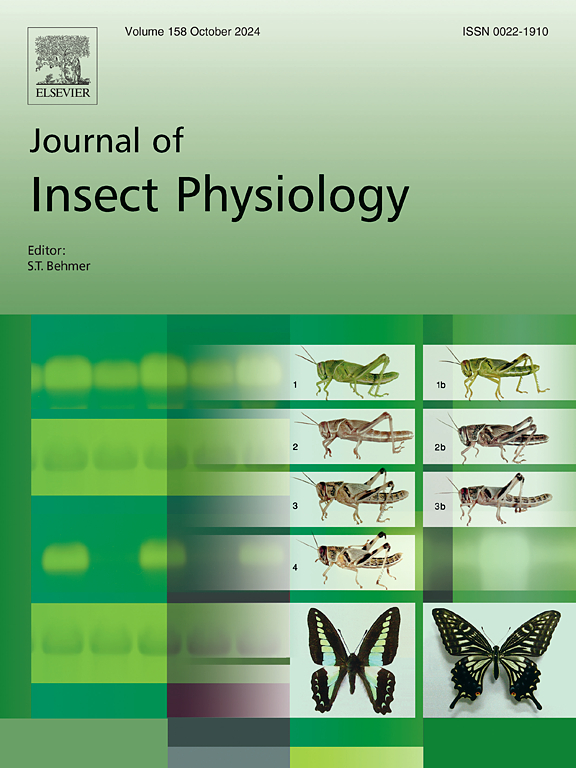Improvement of RNAi efficiency by delivering of dsRNA formulated with cell-penetrating disulfide polymer in the fall Armyworm, Spodoptera frugiperda
IF 2.3
2区 农林科学
Q1 ENTOMOLOGY
引用次数: 0
Abstract
RNA interference (RNAi) has shown excellent potential for pest management worldwide. However, the application of RNAi against insects can be inefficient and unreliable. Finding a better delivery system is a crucial factor for enhancing RNAi efficacy. Here, we present a novel and effective approach of conjugating double-stranded RNA (dsRNA) with a cell-penetrating disulfide polymer (CPD) to improve dsRNA stability and RNAi efficiency. The fall armyworm (FAW), Spodoptera frugiperda, is a globally agricultural insect. Chitin synthase B (CHSB) and methoprene-tolerant (Met) genes, which are essential for the development and growth of FAW, were selected as target genes. The CPD was synthesized using a two-step method for dsRNA delivery. The synthesized CPD/dsRNA complex protected dsRNA from nuclease degradation. The biological application of CPD in Sf9 cells demonstrated low cytotoxicity and high cell viability. Moreover, the CPD-loaded dsRNA entered the cells within 6 h. Bioassays of FAW showed that the relative expression levels of the CHSB and Met genes were reduced. Specifically, at 72 h, the relative expression levels of the CHSB and Met genes were 48.14 % and 37.60 % of those in the control group, respectively. The weight and body length of the larvae decreased significantly, and the mortality rate of CPD/dsCHSB reached 30 %. This CPD was demonstrated for the first time to have excellent delivery performance in insects and is expected to become a new and effective tool for pest control, representing a significant advancement in pest management.
利用细胞穿透二硫聚合物制备的dsRNA在秋粘虫体内的传递提高RNAi效率
RNA干扰(RNAi)技术在世界范围内的病虫害防治中显示出巨大的潜力。然而,RNAi对昆虫的应用效率低且不可靠。寻找更好的递送系统是提高RNAi效能的关键因素。在这里,我们提出了一种新的和有效的方法结合双链RNA (dsRNA)与细胞穿透二硫化物聚合物(CPD),以提高dsRNA的稳定性和RNAi效率。秋粘虫(Spodoptera frugiperda)是一种全球性的农业昆虫。选择几丁质合成酶B (CHSB)和耐甲氧丁烯(Met)基因作为靶基因,这两个基因是FAW发育和生长所必需的。CPD采用两步法合成,用于传递dsRNA。合成的CPD/dsRNA复合物保护dsRNA免受核酸酶降解。CPD在Sf9细胞中的生物学应用显示出低细胞毒性和高细胞活力。此外,cpd负载的dsRNA在6小时内进入细胞。FAW的生物测定显示CHSB和Met基因的相对表达水平降低。其中,72h时CHSB和Met基因的相对表达量分别为对照组的48.14%和37.60%。幼虫体重和体长均显著下降,CPD/dsCHSB致死率达30%。该CPD首次在昆虫中表现出良好的传递性能,有望成为一种新的有效的害虫防治工具,标志着害虫防治的重大进步。
本文章由计算机程序翻译,如有差异,请以英文原文为准。
求助全文
约1分钟内获得全文
求助全文
来源期刊

Journal of insect physiology
生物-昆虫学
CiteScore
4.50
自引率
4.50%
发文量
77
审稿时长
57 days
期刊介绍:
All aspects of insect physiology are published in this journal which will also accept papers on the physiology of other arthropods, if the referees consider the work to be of general interest. The coverage includes endocrinology (in relation to moulting, reproduction and metabolism), pheromones, neurobiology (cellular, integrative and developmental), physiological pharmacology, nutrition (food selection, digestion and absorption), homeostasis, excretion, reproduction and behaviour. Papers covering functional genomics and molecular approaches to physiological problems will also be included. Communications on structure and applied entomology can be published if the subject matter has an explicit bearing on the physiology of arthropods. Review articles and novel method papers are also welcomed.
 求助内容:
求助内容: 应助结果提醒方式:
应助结果提醒方式:


